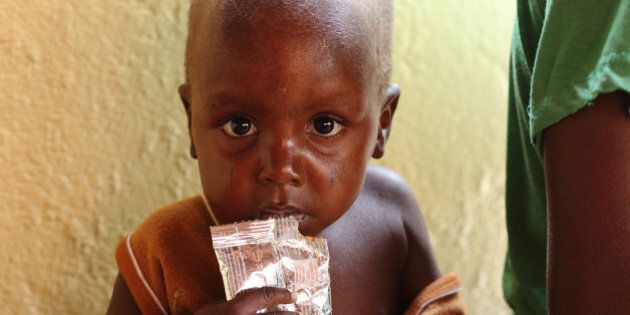

The grocery store aisles are a-buzz with parents and children trying to decide what food they can send their children to school with to ensure they make it through the day happily and healthily, but the worries of what to feed their children start much earlier. Beyond colds and flus, advice on child feeding is one of the top topics of discussion between Canadian caregivers and their physicians, especially in the first two years. In fact, the main reason that parents take their young children to the doctor in Canada is diet related. Even in Canada, when food security isn't an issue for a family, a parent's main focus is ensuring their children are getting the nutrition they need through the right foods.
Why? To make sure they're healthy today and into the future. By giving their child the right quality and quantity of food, a caregiver is trying to do her part to make sure her child's body is strong enough to fend off disease, but also to grow up strong, vibrant and intelligent. Good nutrition is one of the best gifts a caregiver can give a young child, but there are so many decisions to make and conflicting advice and which foods to introduce and in what order.
The same is true for caregivers around world, especially in places where food quality and quantity are an issue. Imagine the worries for caregivers in a context where healthy foods are not available, just not affordable or extremely time consuming to prepare, with lack of access to clean water.
A child grows faster in the first two years of life than any other time. Children's developing bodies and brains require good nutrition to grow, but when a family finds itself unable to afford or access nutrient-rich foods like meat, fresh fruits and vegetables, dairy products, legumes and nuts the child can become increasingly vulnerable to disease and lost potential of growth from hidden hunger.
Our Spin the Plate site tells this story of how food for many children around the world isn't enough. To counter these nutrient deficiencies, MI is working with communities to offer interventions that help young children get the vitamins and minerals critical to their development. Among them, multiple micronutrient powders (MNPs) offer a simple, cost-effective solution for parents looking to ensure their children get the nutrition they need starting at six months when a child needs foods in addition to breast milk. The challenge is often figuring out how to support parents to use this new product.

MNPs, or Chispitas, as they are called in Bolivia, are packets of micro-nutrients that include a range of vitamins and minerals including iron, vitamin A, folic acid, zinc and vitamin C, which parents sprinkle on their children's food. Micronutrient powders are colourless, flavourless powder that can be added into complementary foods that the caregiver has prepared with local staple foods available to her. For parents in Bolivia, they're free and available at health centres around the country, but to be effective caregivers need to feel confident in how to use them, with support from health workers.
To increase their use, MI worked with the Ministry of Health and a local communications agency to create a mass media campaign that included TV and radio ads, roadside billboards, and materials distributed at health posts as well as demonstrations. The campaign was designed to make caregivers aware of the new product, demonstrate how to prepare them and, also to inspire them to use the Chispitas.

Dietary diversity is one approach to increase the nutrition of a diet, but in Ethiopia it is very time-consuming to prepare a flour using the variety of grains and legumes available. One way that has proven successful for MI in Ethiopia has been through community integration in the form of community-based grain banks that are run by local women's groups. Mothers in the village contribute a portion of grains and legumes and then the women at the grain banks process and mill several local grains and legumes to create a flour with improved nutrient density.
The improved grain bank flour is distributed at growth monitoring sessions in the rural communities and sold in the urban areas. Then the grain health extension workers teach moms how to make complementary food recipes out of it with other ingredients they have at home. Even though the concept of weaning wasn't part of the traditional feeding, the mothers and fathers embrace the new "grain bank flour" as they know it is grown from their land. Although, the grain bank flour is much improved, it is still not providing optimal nutrition, and MI is working with the Ministry of Health to bring MNPs to the mothers in Ethiopia so they can fill the nutrient gaps and add them to their recipes, until food security improves.
Change is possible. Long term improved access to locally produced nutrient rich foods is ideal, yet MNPs help to fill the gaps in the short term. Despite barriers and long standing cultural practices we have been able to adapt our communications strategies to engage with caregivers about increasing their opposition to better nutrition for the health of their children. Food is how we access our nutrition, but often it might not be enough. Full bellies might not mean fully nourished. And just like in Canada, the parents MI works with are looking for answers to their questions about their children's diets. Our job is to work with our partners and use the resources available to support caregivers in giving their children optimal nutrition to grow, survive and thrive.